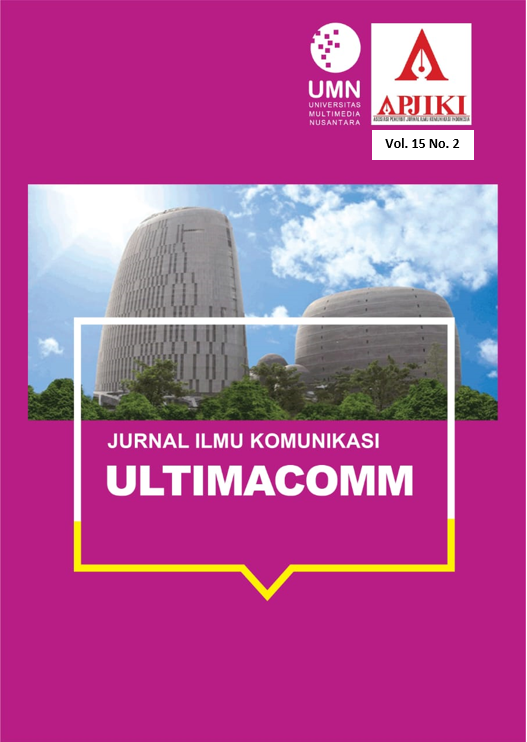Gender-bender: Perceptions of College Students in Tangerang on the Portrayal of Gender Roles in Popular Media
DOI:
https://doi.org/10.31937/ultimacomm.v15i2.3672Keywords:
Media representation, Symbolic boundaries, Gender, Audience reception, Music videoAbstract
Media representation defines social reality by virtue of meanings negotiated through symbols, creating symbolic boundaries that define identities, one of which is gender. Symbolic boundaries of gender have revolved around the roles of masculinity and femininity, much of which were socialized by the media. Dove Cameron's "Breakfast” music video (2022) challenges symbolic boundaries by portraying boundary-crossing through the role reversal of men and women. Through focus group discussions with male and female participants, this study sought to evaluate the way messages of symbolic gender boundaries are portrayed, and how Indonesian young audiences respond to modern representations of gender boundaries. Data were analyzed using the Stuart Hall's Reception Analysis perspective. Results showed that Indonesian younger audiences -male and female- react positively and are receptive to the messages of gender boundary-crossing, and they actively reconstruct the symbolic boundaries of gender. The study ï¬nds that participants have progressive deï¬nitions of gender, with various aspects of their background influencing their views on gender. The symbolic boundaries of gender include characteristic traits, appearance, and sexualities. Ultimately, similar results were gleaned from both the male and female groups.
Downloads
References
Blackstone, A. M. (2003). Gender Roles and Society. In J. R. Miller, et al. (eds), Human Ecology: An Encyclopedia of Children, Families, Communities, and Environments (pp. 335-338). Santa Barbara: ABC-CLIO.
Brooks, D. E. & Hébert, L. P. (2006). Gender, race, and media representation. In B. J. Dow and J. T. Wood (eds), The SAGE Handbook of Gender and Communication (pp. 297-317). Thousand Oaks: Sage.
Bussey, K. & Bandura, A. (1999). ‘Social cognitive theory of gender development and differentiation', Psychological Review, 106(4), pp. 676-713.
Danesi, M. (ed) (2013). Encyclopedia of Media and Communication. Toronto: University of Toronto Press.
Driscoll, C. (2011). Teen Film: A Critical Introduction. New York: Bloomsbury.
Eguchi, S. (2009). ‘Negotiating hegemonic masculinity: The rhetorical strategy of "straight-acting” among gay men', Journal of Intercultural Communication Research, 38(3), pp. 193–209.
Gazzaniga, M. (2018). Psychological Science (6th Ed.). New York: Norton & Company, Inc.
Geiger, J. & Rutsky, R. L. (2013). Film Analysis: A Norton Reader (2nd Ed.). New York: Norton & Company, Inc.
Gerson, J. M. & Peiss, K. (1985). ‘Boundaries, Negotiation, Consciousness: Reconceptualizing Gender Relations', Social Problems, 32(4), pp. 317-331.
Giannetti, L. (1987). Understanding movies. Englewood Cliffs: Prentice Hall.
Gill, R. (2007). Gender and the Media. Malden: Polity Press.
Gorham, B. W. (1999). ‘Stereotypes in the Media : So What?', The Howard Journal of Communications, 10(4), pp. 229-247
Grau, S. L. & Zotos, Y. C. (2016). ‘Gender stereotypes in advertising: a review of current research'. International Journal of Advertising, 35(5), pp. 761-770.
Hall, S. (1999). Encoding, Decoding. In S. During (ed), The Cultural Studies Reader (pp. 507-517), (2nd Ed.). New York: Routledge.
Hall, S. (Ed.). (1997). Representation: Cultural representations and signifying practices. Thousand Oaks: Sage.
Hess, L. (2022). ‘With Her Politically Charged "Breakfast” Video, Dove Cameron Is Making Her Voice Heard'. Vogue [online], August 23, 2022. Available from: https://www.vogue.com/article/dove-ca meron-breakfast-music-video-interview
Hodkinson, P. (2017). Media, Culture and Society: An Introduction. (2nd Ed.).London: Sage.
Hogg, A. M., Terry, D. J. & White, K. M. (1996). ‘A Tale of Two Theories: A Critical Comparison of Identity Theory with Social Identity Theory', Social Psychology Quarterly, 58(4), pp.255–269.
Hollinger, K. (2012). Feminist Film Studies. New York: Routledge.
Hoskin, R. A. (2020). ‘"Femininity? It's the Aesthetic of Subordination”: Examining femmephobia, the gender binary, and experiences of oppression among sexual and gender minorities', Archives of Sexual Behavior, 49(7), pp. 2319–2339.
Kidd, M. A. (2016). ‘Archetypes, stereotypes and media representation in a multi-cultural society', Procedia - Social and Behavioral Sciences, 236, pp. 25-28.
Kožuchová, P. (2018). Non-normative Family on Children's Television: Queering Kinship, Temporality and Reproduction in Steven Universe, Linköping: Linköping University.
Krijnen, T. & Van Bauwel, S. (2015). Gender and Media: Representing, Producing, Consuming, New York: Routledge.
Lamont, M. & Molnár, V. (2002). ‘The Study of Boundaries in the Social Sciences', Annual Review of Sociology, 28, pp. 167-195.
Lauzen, M. M. & Dozier, D. M. (1999). ‘The Role of Women on Screen and behind the Scenes in the Television and Film Industries: Review of a Program of Research', Journal of Communication Inquiry, 23(4), pp. 318-447.
Luhmann, N. (2000). The Reality of the Mass Media. Stanford: Stanford University Press.
Manghani, S. (2017). The Pleasures of (Music) Video. In Arnold, G., et al. (eds), Music/Video: Histories, Aesthetics, Media (pp. 21-40). New York: Bloomsbury.
Martinez, K. D. (2018). Think Outside the Music Video: A Fantasy Theme Analysis of Music Videos that Break the Genre Convention, Abilene: Abilene Christian University.
McKerrell, S. & Way, L. C. S. (2018). Understanding Music as Multimodal Discourse. In McKerrell, S. & Way, L. C. S. (Eds.), Music as Multimodal Discourse: Semiotics, Power and Protest (pp. 1-20). New York: Bloomsbury Academic.
Meidasari, V. E. (2014). ‘Communication Strategies in Translation: An Active Reception Analysis Between the Translation and Readers Reception', English Review: Journal of English Education, 2(2), pp. 183-191.
Mundy, J. (1999). Popular Music on Screen: From Hollywood Musical to Music Video, Manchester: Manchester University Press.
Neroni, H. (2016). Feminist film theory and ‘Cléo from 5 to 7'. New York: Bloomsbury.
Nichols, B. (2010). Engaging Cinema: An Introduction to Film Studies. New York: Norton & Company, Inc.
Oppenheimer, B., Goodman, M., Adams"Price, C., Codling, J., & Coker, J. D. (2003). Audience perceptions of strong female characters on television. Communication Research Reports, 20(2), 161-172.
Orgad, S. (2012). Media Representation and the Global Imagination. Malden: Polity Press.
Railton, D., & Watson, P. (2011). Music Video and The Politics of Representation. Edinburgh: Edinburgh University Press.
Ridell, S. (2021). ‘From Hey, you there! To Got you: re-materializing the encoding/decoding model in the computationally mediated city', Communication and Critical/Cultural Studies, 18(4), pp. 413-420.
Ridgeway, C. L., & Smith-Lovin, L. (1996). ‘Gender and interaction', Social Psychology Quarterly, 59(3), pp. 173–175.
Rishoi, C. (2003). From Girl to Woman: American Women's Coming-of-Age Narratives. Albany: State University of New York Press.
Ross, S. (2011). The Encoding/Decoding Model Revisited, Boston: Stockholm University.
Schweickart, P. P. (1995). Reading Ourselves: Toward a Feminist Theory of Reading. In A. Bennett (ed), Readers and Reading (pp. 66-93), New York: Routledge.
Shuker, R. (2016). Understanding Popular Music Culture, (5th Ed.). New York: Routledge.
Signorielli, N. (2012). Television's Gender-Role Images and Contributions to Stereotyping: Past, Present, Future. In D. G. Singer and J. L. Singer (eds), Handbook of Children and the media (pp. 321–340), (2nd Ed.). Thousand Oaks: Sage.
SkoÄajić, M. M., Radosavljević, J. G., OkiÄić, M. G., Janković, I. O., & Žeželj, I. L. (2020). Boys just don't! Gender stereotyping and sanctioning of counter-stereotypical behavior in preschoolers. Sex Roles, 82, 163-172. Sparks, G. G. (2014). Media Effects Research: A Basic Overview, (5th Ed.). Boston: Cengage Learning.
Thorne, B. (1994). Gender play: Girls and boys in school. New Brunswick: Rutgers University Press.
Van Zoonen, L. (1994). Feminist Media Studies. Thousand Oaks: Sage.
Vernallis, C. (2013). Unruly Media: YouTube, Music Video, and the New Digital Cinema. New York: Oxford University Press.
West, R. & Turner, L. H. (2018). Introducing Communication Analysis and Application (6th Ed.). New York: McGraw-Hill.
Downloads
Published
How to Cite
Issue
Section
License
Ultimacomm Jurnal Ilmu Komunikasi allows readers to read, download, copy, distribute, print, search, or link to its articles' full texts and allows readers to use them for any other lawful purpose. The journal allows the author(s) to hold the copyright without restrictions. Finally, the journal allows the author(s) to retain publishing rights without restrictions
1. Authors are allowed to archive their submitted article in an open access repository
2. Authors are allowed to archive the final published article in an open access repository with an acknowledgment of its initial publication in this journal















